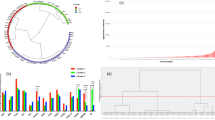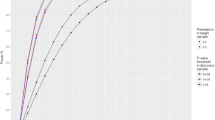Abstract
Definition of disease phenotype is a necessary preliminary to research into genetic causes of a complex disease. Clinical diagnosis of migraine is currently based on diagnostic criteria developed by the International Headache Society. Previously, we examined the natural clustering of these diagnostic symptoms using latent class analysis (LCA) and found that a four-class model was preferred. However, the classes can be ordered such that all symptoms progressively intensify, suggesting that a single continuous variable representing disease severity may provide a better model. Here, we compare two models: item response theory and LCA, each constructed within a Bayesian context. A deviance information criterion is used to assess model fit. We phenotyped our population sample using these models, estimated heritability and conducted genome-wide linkage analysis using Merlin-qtl. LCA with four classes was again preferred. After transformation, phenotypic trait values derived from both models are highly correlated (correlation = 0.99) and consequently results from subsequent genetic analyses were similar. Heritability was estimated at 0.37, while multipoint linkage analysis produced genome-wide significant linkage to chromosome 7q31-q33 and suggestive linkage to chromosomes 1 and 2. We argue that such continuous measures are a powerful tool for identifying genes contributing to migraine susceptibility.





Similar content being viewed by others
References
Abecasis GR, Cherny SS, Cookson WOC, Cardon LR (2001) Grr: graphical representation of relationship errors
Abecasis GR, Cherny SS, Cookson WO, Cardon LR (2002) Merlinrapid analysis of dense genetic maps using sparse gene flow trees. Nat Genet 30:97–101
Anttila V, Kallela M, Oswell G, Kaunisto MA, Nyholt DR, Hamalainen E, Havanka H, Ilmavirta M, Terwilliger J, Sobel E (2006) Trait components provide tools to dissect the genetic susceptibility of migraine. Am J Hum Genet 79(1):85–99
Anttila V, Nyholt DR, Kallela M, Artto V, Vepsäläinen S, Jakkula E, Wennerström A, Tikka-Kleemola P, Kaunisto MA, Hämäläinen E (2008) Consistently replicating locus linked to migraine on 10q22-q23. Am J Hum Genet 82(5):1051–1063
Björnsson A, Gudmundsson G, Gudfinnsson E, Hrafnsdóttir M, Benedikz J, Skúladóttir S, Kristjánsson K, Frigge ML, Kong A, Stefánsson K, Gulcher JR (2003) Localization of a gene for migraine without aura to chromosome 4q21. Am J Hum Genet 73(5):986–993
Cader ZM, Noble-Topham S, Dyment DA, Cherny SS, Brown JD, Rice GPA, Ebers GC (2003) Significant linkage to migraine with aura on chromosome 11q24. Hum Mol Genet 12(19):2511–2517
Cassidy F, Pieper CF, Carroll BJ (2001) Subtypes of mania determined by grade of membership analysis. Neuropsychopharmacology 25(3):373–83
Celeux G, Forbes F, Robert C, Titterington M (2006) Deviance information criteria for missing data models. Bayesian Statistics. p 6
Chen CCM, Mengersen KL, Keith JM, Martin NG, Nyholt DR (2009) Linkage and heritability analysis of migraine symptom groupings: a comparison of three different clustering methods on twin data (submitted)
Corder EH, Woodbury MA (1993) Genetic heterogeneity in alzheimer’s disease: a grade of membership analysis. Genet Epidemiol 10:495–499
Cornes BK, Medland SE, Ferreira MAR, Morley KI, Duffy DL, Heijmans BT, Montgomery GW, Martin NG (2005) Sex-limited genome-wide linkage scan for body mass index in an unselected sample of 933 australian twin families. Twin Res Hum Genet 8(6):616–632
De Fusco M, Marconi R, Silvestri L, Atorino L, Rampoldi L, Morgante L, Ballabio A, Aridon P, Casari G (2003) Haploinsufficiency of atp1a2 encoding the Na+/K+ pump alpha2 subunit associated with familial hemiplegic migraine type 2. Nat Genet 33(2):192–6
Devlin B, Bacanu SA, Klump KL, Bulik CM, Fichter MM, Halmi KA, Kaplan AS, Strober M, Treasure J, Woodside DB (2002) Linkage analysis of anorexia nervosa incorporating behavioral covariates. Hum Mol Genet 11(6):689–696
Dichgans M, Freilinger T, Eckstein G, Babini E, Lorenz-Depiereux B, Biskup S, Ferrari MD, Herzog J, van den Maagdenberg A, Pusch M (2005) Mutation in the neuronal voltage-gated sodium channel scn1a in familial hemiplegic migraine. Lancet 366(9483):371–377
Duffy DL (2002) Sib-pair version 099 9. Queensland Institute of Medical Research, Brisbane, Australia
Duren WL, Epstein MP, Li M, Boehnke M (2003) Relpair: a program that infers the relationships of pairs of individuals based on marker data
Eaves L, Silberg J, Foley D, Bulik C, Maes H, Erkanli A, Angold A, Costello EJ, Worthman C (2004) Genetic and environmental influences on the relative timing of pubertal change. Twin Res 7(5):471–481
Eaves L, Erkanli A, Silberg J, Angold A, Maes HH, Foley D (2005) Application of bayesian inference using gibbs sampling to item-response theory modeling of multi-symptom genetic data. Behav Genet 35(6):765–780
Epstein MP, Duren WL, Boehnke M (2000) Improved inference of relationship for pairs of individuals. Am J Hum Genet 67(5):1219–1231
Fillenbaum GG (1998) Typology of alzheimer’s disease: findings from cerad data. Aging Mental Health 2(2):105–127
Hallmayer JF, Jablensky A, Michie P, Woodbury M, Salmon B, Combrinck J, Wichmann H, Rock D, Ercole MD, Howell S, Dragovic M, Kent A (2003) Linkage analysis of candidate regions using a composite neurocognitive phenotype correlated with schizophrenia. Mol Psychiatry 8(5):511
Headache Classification Committee of the International Headache Society (1988) Classification and diagnostic criteria for headache disorders, cranial neuralgias and facial pain. Cephalagia 8:1–96
Jones KW, Ehm MG, Pericak-Vance MA, Haines JL, Boyd PR, Peroutka SJ (2001) Migraine with aura susceptibility locus on chromosome 19p13 is distinct from the familial hemiplegic migraine locus. Genomics 78(3):150–154
Kaabi B, Gelernter J, Woods SW, Goddard A, Page GP, Elston RC (2006) Genome scan for loci predisposing to anxiety disorders using a novel multivariate approach: strong evidence for a chromosome 4 risk locus. Am J Hum Genet 78:543
Kaufman L, Rousseeuw PJ (1990) Finding groups in data : an introduction to cluster analysis. Applied probability and statistics. Wiley series in probability and mathematical statistics. Wiley, New York
Kong A, Cox NJ (1997) Allele-sharing models: Lod scores and accurate linkage tests. Am J Hum Genet 61(5):1179–1188
Kong X, Murphy K, Raj T, He C, White PS, Matise TC (2004) A combined linkage-physical map of the human genome. Am J Hum Genet 75(6):1143–8
Kruglyak L, Daly MJ, Reeve-Daly MP, Lander ES (1996) Parametric and nonparametric linkage analysis: a unified multipoint approach. Am J Hum Genet 58(6):1347–1363
Lange K, Weeks D, Boehnke M (1988) Programs for pedigree analysis: Mendel, fisher, and dgene. Genet Epidemiol 5(6):471–2
Ligthart L, Boomsma DI, Martin NG, Stubbe JH, Nyholt DR (2006) Migraine with aura and migraine without aura are not distinct entities: further evidence from a large dutch population study. Twin Res Hum Genet 9(1):54–63
Ligthart L, Nyholt DR, Hottenga JJ, Distel MA, Willemsen G, Boomsma DI (2008) A genome-wide linkage scan provides evidence for both new and previously reported loci influencing common migraine. Am J Med Genet B Neuropsychiatr Genet 147B(7):1186–1195
McLachlan GJ, Do KA, Ambroise C (2005) Analyzing microarray gene expression data. Wiley, New York
Mulder EJ, Van Baal C, Gaist D, Kallela M, Kaprio J, Svensson DA, Nyholt DR, Martin NG, MacGregor AJ, Cherkas LF (2003) Genetic and environmental influences on migraine: a twin study across six countries. Twin Res 6(5):422–31
Neale MC (1997) MX: statistical modeling. Department of Psychiatry, Medical College of Virginia
Nyholt DR, Gillespie NG, Heath AC, Merikangas KR, Duffy DL, Matrin NG (2004) Latent class and genetic analysis does not support migraine with aura and migraine without aura as separate entities. Genet Epidemiol 26:231–244
Nyholt DR, Morley KI, Ferreira MAR, Medland SE, Boomsma DI, Heath AC, Merikangas KR, Montgomery GW, Matrin NG (2005) Genomewide significant linkage to migrainous headache on chromosome 5q21. Am J Hum Genet 77:500–512
Olesen J, Steiner TJ (2004) The international classification of headache disorders, 2nd edn (ICHD-ii). Br Med J 75(6):808
Schwarz G (1978) Estimating the dimension of a model. Ann Stat 6(2):461–464
Silberstein S, Olesen J, Bousser MG, Diener HC, Dodick D, First M, Goadsby P, Gobel H, Lainez M, Lance J (2005) The international classification of headache disorders, (ICHD-ii)-revision of criteria for 8.2 medication-overuse headache. Cephalalgia 25(6):460–465
Soragna D, Vettori A, Carraro G, Marchioni E, Vazza G, Bellini S, Tupler R, Savoldi F, Mostacciuolo ML (2003) A locus for migraine without aura maps on chromosome 14q21.2-q22.3. Am J Hum Genet 72(1):161
Spiegelhalter D, Thomas A, Best N, Lunn D (2006) Winbugs 1.4. 1. bayesian inference using gibbs sampling
Spiegelhalter DJ, Best NG, Carlin BP, van der Linde A (2002) Bayesian measures of model complexity and fit. J Roy Stat Soc B 64(4):583–639
Svensson DA, Larsson B, Waldenlind E, Pedersen NL (2003) Shared rearing environment in migraine: results from twins reared apart and twins reared together. Headache 43(3):235–244
Svensson DA, Waldenlind E, Ekbom K, Pedersen NL (2004) Heritability of migraine as a function of definition. Headache 5(3):171
Vanmolkot KR, Kors EE, Hottenga JJ, Terwindt GM, Haan J, Hoefnagels WA, Black DF, Sandkuijl LA, Frants RR, Ferrari MD (2003) Novel mutations in the Na+, K+-ATPase pump gene atp1a2 associated with familial hemiplegic migraine and benign familial infantile convulsions. Ann Neurol 54(3):360–6
Wessman M, Kallela M, Kunisto MA, Marttila P, Sobel E, Hartiala J, Oswell G, Leal SM, Papp JC, Hämäläinen E, Broas P, Joslyn G, Hovatta I, Hiekkalinna T, Kaprio J, Ott J, Cantor RM, Zwart JA, Ilmavirta M (2002) A susceptibility locus for migraine with aura, on chromosome 4q24. Am J Hum Genet 70(3):652
Wessman M, Terwindt GM, Kaunisto MA, Palotie A, Ophoff RA (2007) Migraine: a complex genetic disorder. Lancet Neurol 6(6):521–532
Whittemore AS, Halpern J (1994) A class of tests for linkage using affected pedigree members. Biometrics 50(1):118–127
Woodbury MA, Clive J, Garson Jr A (1978) Mathematical typology: a grade of membership technique for obtaining disease definition. Comput Biomed Res 11(3):277–98
Wray NR, Coventry WL, James MR, Montgomery GW, Eaves LJ, Martin NG (2008) Use of monozygotic twins to investigate the relationship between 5httlpr genotype, depression and stressful life events: an application of item response theory. In: Rutter M (ed) Novartis Foundation Sympoisum, Genetic effects on environmental vulnerability to disease, vol. 293, pp 48–68
Zhu G, Evans DM, Duffy DL, Montgomery GW, Medland SE, Gillespie NA, Ewen KR, Jewell M, Liew YW, Hayward NK (2004) A genome scan for eye color in 502 twin families: most variation is due to a qtl on chromosome 15q. Twin Res 7(2):197–210
Ziegler DK, Hur YM, Bouchard TJ, Hassanein RS, Barter R (1998) Migraine in twins raised together and apart. Headache 38(6):417–422
Acknowledgments
This study is funded by National Health and Medical Research Council capacity Building grant (grant number 389892) and Professor Peter Visscher for the constructive advice. The authors would also like to thank Professor Lindon Eaves of the Virginia Institute for Psychiatric and Behavioral Genetics for his help on the Item Response theory model.
Author information
Authors and Affiliations
Corresponding author
Appendix 1
Appendix 1
DIC3 is the difference between twice the posterior mean deviance and the deviance of estimated η
In the DIC3 proposed by Celeux et al. (2006), when the likelihood has a closed form, the first term can be approximated using M simulated values, \(\eta^{(1)},{\ldots},\eta^{(M)},\) where \(\eta^{(m)}=(p^{m}, \lambda^{m})\) from an MCMC chain.
The second term of Eq. 3 we used here is the posterior expectation, \({\mathbb{E}}[f(y|\eta)|y]\) which is also approximated using the parameters of an MCMC chain.
From Eqs. 5 and 6, Eq. 3 is the expanded form of Eq. 4. In the Bayesian LCA model, \(f(y|\eta^{(m)})\) is
and the posterior mean deviance is
and \(D(\hat{\eta})\) is
For the Bayesian IRT model, the likelihood is
therefore \(\overline{D(\eta)}\) is
and \(D(\hat{\eta})\) is
Rights and permissions
About this article
Cite this article
Chen, C.C.M., Keith, J.M., Nyholt, D.R. et al. Bayesian latent trait modeling of migraine symptom data. Hum Genet 126, 277–288 (2009). https://doi.org/10.1007/s00439-009-0671-4
Received:
Accepted:
Published:
Issue Date:
DOI: https://doi.org/10.1007/s00439-009-0671-4




